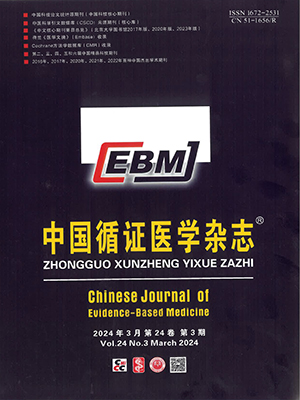| 1. |
Sackett DL, Rosenberg WM, Gray JA, et al. Evidence based medicine: what it is and what it isn't. BMJ, 1996, 312(7023): 71-72.
|
| 2. |
Evidence-Based Medicine Working Group. Evidence-based medicine. A new approach to teaching the practice of medicine. JAMA, 1992, 268(17): 2420-2425.
|
| 3. |
Marshall J, Ross S, Buchanan P, et al. Providing effective evidence based support for breastfeeding women in primary care. BMJ, 2021, 375: e065927.
|
| 4. |
Peng L, Zhang K, Li Y, et al. Real-world evidence of traditional Chinese medicine (TCM) treatment on cancer: a literature-based review. Evid Based Complement Alternat Med, 2022, 2022: 7770380.
|
| 5. |
Zeng L, Walsh M, Guyatt GH, et al. Plasma exchange and glucocorticoid dosing for patients with ANCA-associated vasculitis: a clinical practice guideline. BMJ, 2022, 376: e064597.
|
| 6. |
Carson JL, Stanworth SJ, Guyatt G, et al. Red blood cell transfusion: 2023 AABB international guidelines. JAMA, 2023, 330(19): 1892-1902.
|
| 7. |
Harris E. CDC introduces hospital sepsis program guidelines. JAMA, 2023, 330(12): 1128.
|
| 8. |
Gilbert R, Salanti G, Harden M, et al. Infant sleeping position and the sudden infant death syndrome: systematic review of observational studies and historical review of recommendations from 1940 to 2002. Int J Epidemiol, 2005, 34(4): 874-887.
|
| 9. |
Tan J, Liu C, Li M, et al. A methodological framework for tackling confounding by indication when assessing the treatment effects of Chinese herbal injections in the real world. J Evid Based Med, 2022, 15(1): 64-72.
|
| 10. |
樊鹏. 第四次工业革命带给世界的深刻变革. 人民论坛, 2021, (Z1): 41-45.
|
| 11. |
Al Shahrani AS. Development and evaluation of an evidence-based medicine module in the undergraduate medical curriculum. BMC Med Educ, 2020, 20(1): 256.
|
| 12. |
Dorsch JL, Aiyer MK, Meyer LE. Impact of an evidence-based medicine curriculum on medical students' attitudes and skills. J Med Libr Assoc, 2004, 92(4): 397-406.
|
| 13. |
Psaty BM, Siscovick DS. Minimizing bias due to confounding by indication in comparative effectiveness research: the importance of restriction. JAMA, 2010, 304(8): 897-898.
|
| 14. |
Lund JL, Richardson DB, Stürmer T. The active comparator, new user study design in pharmacoepidemiology: historical foundations and contemporary application. Curr Epidemiol Rep, 2015, 2(4): 221-228.
|
| 15. |
Yoshida K, Solomon DH, Kim SC. Active-comparator design and new-user design in observational studies. Nat Rev Rheumatol, 2015, 11(7): 437-441.
|
| 16. |
复旦大学. 中国大学MOOC(慕课): 循证医学. 2023.
|
| 17. |
张维璐, 邵中军, 苏海霞, 等. 医学院校硕士研究生科研素养提升教学模式探讨—以《临床流行病学与循证医学》课程为例. 医学教育研究与实践, 2023, 31(5): 552-556.
|
| 18. |
刘智洁, 郑紫薇, 肖元梅, 等. 医学研究生循证能力的表现形式及培养方式. 医学教育管理, 2023, 9(5): 599-604.
|
| 19. |
Thomas A, Chin-Yee B, Mercuri M. Thirty years of teaching evidence-based medicine: have we been getting it all wrong. Adv Health Sci Educ Theory Pract, 2022, 27(1): 263-276.
|
| 20. |
Subbiah V. The next generation of evidence-based medicine. Nat Med, 2023, 29(1): 49-58.
|
| 21. |
Luo J, Wu M, Gopukumar D, et al. Big data application in biomedical research and health care: a literature review. Biomed Inform Insights, 2016, 8: 1-10.
|
| 22. |
Djulbegovic B, Guyatt GH. Progress in evidence-based medicine: a quarter century on. Lancet, 2017, 390(10092): 415-423.
|
| 23. |
Siemieniuk RA, Agoritsas T, Macdonald H, et al. Introduction to BMJ rapid recommendations. BMJ, 2016, 354: i5191.
|




